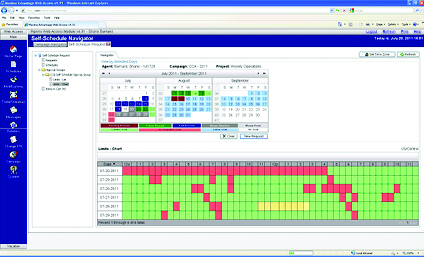Technology, including advancements in agent scheduling, has enabled contact centers to integrate remote agents into their labor pool. The use of at-home agents continues to rise as more companies experience the benefits of decreased costs associated with part-time employees and reduction in brick and mortar facilities, improved customer service, and flexible scheduling options. Experts have cited the advantage of remote agents being more educated and qualified than in-house agents, as well as the effects of satisfied agents having improved morale and work-life balance, which translates into improved customer service leading to both agent and customer retention.
One of the biggest advantages of at-home agents is the flexibility provided by agents who can work segmented shifts and be available for spikes in call volume at a moment’s notice without incurring additional overtime costs. Concomitant with the popularity of remote agents has been the development of new user-friendly software tools that provide a level of efficiency not previously experienced.
Indeed, the At-Home Agent Model has revolutionized the way contact centers are staffed. Software tools have been available for helping increase agent control over schedules; however, the At-Home Model supersedes software solutions offered to on-site agents. Remote agents can now create schedules unique to their availability and can be segmented throughout the day. Schedules can vary on a daily basis to fill any required staffing need, creating a win-win situation for both the center as well as agents.
Agents now have more control over their work schedules resulting in improved efficiency for the center. Features of self-scheduling software tools expand agent scheduling
capabilities by allowing:
• agent scheduling through an easy agent self-service scheduling tool.
• a checkout method for self-scheduling to accommodate staffing requirements based on business needs.
• schedules that can be created in blocks of time to accommodate both the center as well as agent’s personal needs.
Remote agents have the ability to pick and choose blocks of time in which they build their own shifts according to established company rules, business needs, and staffing requirements. While self-scheduling simplifies the process, supervisors are still responsible for ensuring their centers are properly staffed, and centers are still at risk for inaccurate scheduling without proper tools.
Agent time off requests for vacation and holidays are ongoing and in the past contact centers were threatened with over- and understaffing when agents requested time off and overtime was needed. This threat has been eliminated with self-scheduling tools that ensure available slots are filled according to staffing needs rather than agent availability. Over- and understaffing have the biggest impact on a center’s bottom line profits. When understaffing occurs, the percentage of calls answered within any established performance objective will drop, resulting in abandoned calls and lost profit, while overstaffing results in idle agents and wasted labor expense.
Agent self-scheduling tools virtually eliminate complications of vacation, holiday, and special event staffing, including the need for supervisors to limit agent time off. Staffing
requirements can be easily filled with no gaps in service as agents view available time slots and choose work hours compatible with their schedules.
 Agents use a checkout method for self-scheduling to accommodate staffing requirements based on business needs. The scheduling process ensures rules specific to organizational needs are met, including break and lunch times, hours worked, and any other specific needs.
Agents use a checkout method for self-scheduling to accommodate staffing requirements based on business needs. The scheduling process ensures rules specific to organizational needs are met, including break and lunch times, hours worked, and any other specific needs.
With a limitless remote agent pool, supervisors have:
• various configurations of agent scheduling options.
• simplified staffing for special events and holidays by remote agents with flexible schedules.
• accommodation for spikes in call volume on short notice by remote agents, ensuring holiday fluctuations are fully staffed .
Intra-day optimization is also simplified with at-home agent self-scheduling. When agents cannot fill their allotted time slots, supervisors can notify remote agents and receive help quickly without disruption to service levels. This feature is critical for juggling holiday staffing issues. Last-minute schedule changes and overtime requests can be sent to agents’ computer screens via pop-up messages. Supervisors can quickly review current-day staffing and recalculate those needs for the day through an intra-day analysis function with confidence that staffing needs will be accommodated by at-home agents.
Any company who employs at-home agents should provide supervisors with tools that allow for maximum efficiency in agent scheduling, intra-day optimization, and ensuring agents have the most control possible over their work-life balance. The self-scheduling tool accomplishes these objectives and streamlines the process for both agents and supervisors.
About Pipkins
Pipkins, Inc., founded in 1983, is a leading supplier of workforce management (WFM) software and services to the contact center industry, providing sophisticated forecasting and scheduling technology for both the front and back office. Pipkins’ @HomeVantage self-scheduling tool uses a checkout method for self-scheduling to accommodate staffing requirements based on business needs, giving agents more control over their work schedules and resulting in improved efficiency for the center. Its award-winning Vantage Point is the most accurate forecasting and scheduling tool on the market. Pipkins’ systems forecast and schedule more than 300,000 agents in over 500 locations across all industries worldwide. For more information, visit www.Pipkins.com.
